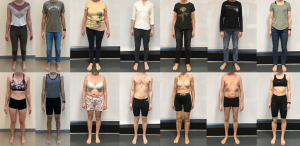The Dresscode for OpenCap: Impact of Clothing on Measured Lower-Limb Joint Kinematics Using a Smartphone-Based Markerless Motion Capture System
Aim and Research Question(s)
The aim of the thesis is to answer the following research question: Is there a clinically relevant impact of the clothing condition on the smartphone-based, markerless motion capture system OpenCap to quantify lower-limb joint kinematics of healthy adults while performing different motion patterns?
Background
Markerless motion capture systems, like OpenCap, offer significant advantages by eliminating the need for laboratory setups and reflective markers. As a result, they can lead to time and cost savings, making it easier to conduct large-scale research studies under field conditions, where participants do not need to undress (Keller et al., 2022). While Findings for the markerless system Theia3D suggest no clinically relevant effects of clothing on measured kinematics, data for OpenCap are non-existent so far.
Methods
The study took place at FH St. Pölten in March 2024. 17 female and 17 male healthy volunteers with a mean age of 40 years (SD: 14) and a BMI of 23.4 kg/m2 (SD: 3.4) were recruited to perform normal walking and sit-to-stand in casual and in sports clothing. OpenCap was used with two iOS smartphones mounted on tripods. The kinematics of one lower extremity of five gait and five sit-to-stand cycles per participant were used for analysis. Root-Mean-Square-Deviations (RMSD) were calculated between clothing for nine kinematic variables. Statistical significance for clinically relevant events was assessed using the paired t-test and the Wilcoxon signed-rank test.

Results and Discussion
The RMSD of 4.9° (SD: 2.7°) between clothing conditions across all kinematic variables and for both tasks is considered clinically relevant. The overall p-value of <0.05 for clinically relevant events indicates a statistically significant difference between the clothing conditions. However, this average RMSD is only slightly greater than OpenCaps's inter-session variability described by Horsak and Dumphart (2024), which is 3.6°. Therefore, these results support those of Keller et al. (2022), who did not describe relevant differences regarding clothing.
Conclusion
Since certain kinematic parameters exhibit substantially high deviations between clothing, it is recommended to examine participants minimally clothed. Nevertheless, in scenarios where it is challenging to have participants undress, such as in large Ield studies, it may be reasonable to disregard clothing.
References
Horsak, B., & Dumphart, B. (2024). Inter-Session Repeatability of a Smartphone-Based 3D Markerless System to Assess Joint Kinematics for Walking and a Sit-to-Stand Task. Submitted to the ESMAC Conference, (unpublished) Keller, V. T., Outerleys, J. B., Kanko, R. M., Laende, E. K., & Deluzio, K. J. (2022). Clothing condition does not affect meaningful clinical interpretation in markerless motion capture. Journal of Biomechanics, 141, 111182. https://doi.org/10.1016/j.jbiomech.2022.111182
